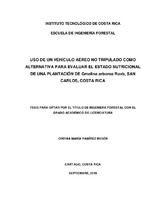| dc.contributor.advisor | Guevara-Bonilla, Mario | es |
| dc.contributor.author | Ramírez-Mesén, Cinthia María | |
| dc.date.accessioned | 2020-03-04T22:46:01Z | |
| dc.date.available | 2020-03-04T22:46:01Z | |
| dc.date.issued | 2019 | |
| dc.identifier.uri | https://hdl.handle.net/2238/11154 | |
| dc.description | Trabajo Final de Graduación (Licenciatura en Ingeniería Forestal) Instituto Tecnológico de Costa Rica, Escuela de Ingeniería Forestal, 2019. | es |
| dc.description.abstract | La melina es una especie altamente utilizada para reforestación, sin embargo, no se suele fertilizar correctamente, para lo cual es importante conocer el estado nutricional de las plantaciones. Tradicionalmente se realizan análisis químicos foliares y/o del suelo, lo cual demanda tiempo y dinero. El presente estudio tiene como objetivo validar el uso de un Vehículo Aéreo no Tripulado (VANT) como una opción para evaluar el estado nutricional en Gmelina arborea Roxb. Se establecieron ocho puntos de muestreo y en cada uno se tomaron muestras foliares y de suelo; se midió diámetro, altura y valores de contenido relativo de clorofila, este último mediante un SPAD. Con el VANT se tomaron imágenes RGB y multiespectrales. Se obtuvo valores bajos en los índices de vegetación, principalmente en GLI y NGRDI. La vigorosidad de la plantación es baja (0,21-0,39). Se muestra una correlación alta y positiva entre NGRDI (marzo: R=0,82, mayo: R=0,73) versus el contenido relativo de clorofila. La relación entre índices de vegetación y volumen es alta y positiva para el NDVI (R=0,75), GLI (R=0,79) y NRGDI (R=0,84), los dos últimos de mayo. El nitrógeno obtuvo una correlación alta y positiva con el NGRDI (R=0,80). El volumen y contenido relativo de clorofila presentan correlaciones moderadas (marzo: R=0,54, mayo: R=0,63). Por otro lado, las relaciones entre volumen y contenido relativo de clorofila versus nitrógeno no siguen un patrón, debido a las variaciones en el contenido de nitrógeno. El uso de imágenes de VANT para el cálculo de índices de vegetación es una herramienta útil que permite obtener una referencia sobre el estado de las plantas, mas no sustituye los métodos tradicionales de análisis nutricional. | es |
| dc.description.abstract | Melina is a highly used specie for reforestation, however, it is not usually fertilized correctly, for which it is important to know the nutritional status of the plantations. Foliar and soil analyzes are commonly performed, which requires time and money. The objective of this study is to validate the use of an Unmanned Aerial Vehicle (UAV) as an option to assess the nutritional status of Gmelina arborea Roxb. Eight sampling points were established, in each one foliar and soil samples were taken, and diameter, height and chlorophyll content values were measure, the latter using a SPAD. RGB and multispectral images were taken with the UAV. The results of vegetation indices were low, mainly in GLI and NGRDI. The plantation vigor was low (0,21-0,39). A high correlation between NGRDI (March: R=0,82, May: R=0,73) versus relative chlorophyll content is shown. The relationship between vegetation indices and volume is high and positive for NDVI (R=0,75), GLI (R=0,79) and NRGDI (R=0,84), the last two of May. Nitrogen obtained a positive and high correlation with NGRDI (R=0,80). The volume and relative chlorophyll content have moderate correlations (March: R=0,54, May: R=0,63). On the other hand, the relationships between the volume and the relative content chlorophyll versus nitrogen do not follow a pattern, due to the variations in nitrogen content. The use of UAV images for the calculation of vegetation indices is a useful tool that allows obtaining a reference on the nutritional status of plants, however, this does not replace the traditional methods of nutritional analysis. | es |
| dc.language.iso | spa | es |
| dc.publisher | Instituto Tecnológico de Costa Rica | es |
| dc.rights | Attribution 4.0 International | * |
| dc.rights.uri | https://creativecommons.org/licenses/by/4.0/ | * |
| dc.subject | Especies para reforestación | es |
| dc.subject | Vehículo Aéreo no Tripulado (VANT) | es |
| dc.subject | Nutrición forestal | es |
| dc.subject | Species for reforestation | es |
| dc.subject | Unmanned Aerial Vehicle (UAV) | es |
| dc.subject | Forest nutrition | es |
| dc.subject | Research Subject Categories::FORESTRY, AGRICULTURAL SCIENCES and LANDSCAPE PLANNING::Area technology::Forest engineering | es |
| dc.subject | Índices | es |
| dc.subject | Vegetación | es |
| dc.subject | Vegetation | es |
| dc.subject | Melina | es |
| dc.title | Uso de un vehículo aéreo no tripulado como alternativa para evaluar el estado nutricional de una plantación de Gmelina arborea Roxb, San Carlos, Costa Rica | es |
| dc.type | licentiateThesis | es |



